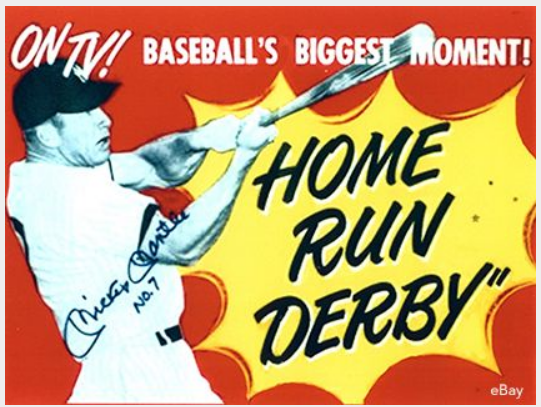
Next month Dodger Stadium will host this year’s All-Star game. Among the many festivities surrounding the game will be the Home Run Derby. A glitzy, highly promoted television spectacle attended by thousands of fans. Thinking about that, I was reminded of the Home Run Derby of my youth. I like to share some of those memories with you in this post.
As a nine year old growing up in the little community of Dairy Valley, California (now known as Cerritos), I wasn’t afforded the opportunity to watch a great deal of television. Not only did we have a limited number of channels to watch (2, 4, 5, 7, 9, 11 and 13), parents simply didn’t use the TV as a baby sitter back then. Moreover, there were always chores to do around the house and the dairy. Every morning, I had to feed the cows, both in and out of the barn, and afterwards I had to broom clean the hay alleys. My parent also had a gravel driveway to our garage and it was my Saturday morning duty to rake that sucker in a herringbone pattern and make sure that not a weed was to be found. I hated that job. In Dutch culture, the old adage of “cleanliness is next to godliness” was much more than a way of life, it was an obsession. Every so often, however, if I had finished all of my chores quickly and properly, I was allowed to watch some Saturday morning TV. I relished that chance. However, rather than watch cartoons, I took that opportunity to watch the weekly television show, Home Run Derby. I loved that show!!
Looking back on that program now, I have to admit that it was hokey and cliched, but in 1960 it provided then 9 year old Robbie, and many like me, the opportunity to see the players I idolized including, with a couple of exceptions, the most prolific home run hitters of that era, go toe to toe in a home run battle. The participants included nine future Hall of Famers: Hank Aaron, Ernie Banks, Al Kaline, Harmon Killebrew, Mickey Mantle, Eddie Mathews, Willie Mays, Frank Robinson and Duke Snider. Of the 20 players who had hit 25 or more home runs during the 1959 season, all but four (Joe Adcock, Orlando Cepeda, Woodie Held, and Charlie Maxwell) would appear on Home Run Derby. Other well-known stars of the day included Bob Allison, Ken Boyer, Bob Cerv, Rocky Colavito, Gil Hodges, Wally Post (best remembered for hitting the first home run at Dodger Stadium), Gus Triandos and Dick Stuart. Fifteen of the 16 major league teams were represented. The missing club, the American League champion Chicago White Sox, who had no players with more than 22 home runs in 1959.
Not only did you get to see these players perform, you got hear them talk. Up until then, for most of these players, they were only “known” as part of my baseball card collection. Now mind you, the typical dialogue wasn’t all that spell binding, but it made these players seem more real. In and interview with The National Pastime magazine in 1997, Ernie Banks explained, “We could not believe we were on television and we didn’t know what to say. Mark Scott was very relaxing. He kept asking us various things, but we were told to keep it going and make comments. But we didn’t know how to make comments because it was very new to us.” Looking back at the show now, it is a reminder of the simplicity of life back then.
The show was filmed over a three week period in December 1959. More often than not, two shows would be filmed per day. Each derby took place at Los Angeles’ Wrigley Field, home of the minor league Los Angeles Angels during their time in the Pacific Coast League. The park was located in South Los Angeles, at the intersection of Avalon Boulevard and 42nd Place, although the show never mentioned where the Derby was taking place. Wrigley Field had fairly symmetrical dimensions, making it fair for both right-handed and left-handed hitters. It was 340 feet down each line, 412 to dead center and just 345 in the power alleys. The only difference was that the height of the left field wall was 14.5 feet, whereas the right field fence was only nine feet high. Other than the host, the participants, the umpire, a pitcher and 3 outfielders, and the filming crew, there were no fans in attendance. The show had a Twilight Zone feel to it in that it seemed dark and grainy, you could seldom see where the ball went after it was hit and, because Wrigley park was in a residential neighborhood, it often looked like home runs were hit into someone’s back yard. It could seem eerily quiet.
Although it seemed to me to have run longer, the show aired for only one season, from January 9, 1960 through July 2, 1960. The show was hosted by Mark Scott, who was an actor and broadcaster. As an actor, he had minor roles in television series such as Dragnet and Boston Blackie and in “B” movies such as Hell’s Horizon. He was an announcer in 1956 for the Cincinnati Redlegs of Major League Baseball and in 1957 for the Hollywood Stars of the Pacific Coast League. Scott quickly became a well-known figure in the Hollywood/Los Angeles scene. He did Stars games and was sports director at radio station KFWB, announcing boxing matches, horse and dog races, and hosting a daily 15-minute radio show, “Mark Scott’s Pressbox.” When the Dodgers brought major league baseball to Los Angeles in 1958, Scott became host of the “Meet the Dodgers” television show. He is, however, best known for his hosting role on Home Run Derby.
The show always started with an announcer, who sounded remarkably like Ross Porter, giving an overview of the show and the stars who would be participating in the Derby. Then Mark Scott would introduce the two players participating in that show’s match. His introduction was virtually always the same. First, he would describe the rules: The hitters would each have nine-innings of three outs each. There was a “home” hitter and a “visitor” hitter. The object was to hit as many home runs as they could before hitting into three “outs” in the inning. Any hit, other than a homerun, was considered an out. If the batter took a pitch and the umpire determined it was a strike, he would also be “out.” The player who hit more total home runs over the nine innings won the contest, earning the right to come back to participate in another program. Scott would also add, “Gentlemen, today you’re going for the big money,” and then he would remind them and the audience: “It’s a home run or nothing here on Home Run Derby.”
Scott would always describe what the “big money” was that the players were competing for. Prize money for the ballplayers consisted of $2,000.00 for the winner of each show and $1,000.00 for the loser. A hitter could also receive a $500.00 bonus if he hit three straight home runs without making an out. If he hit four straight homeruns he received $1,000.00 dollars. When told what the prize money would be, Frank Robinson, classically responded “wow!” As he would explain later, “Hey, that was a lot of money back then.” In deed it was, when you consider that the World Series winner’s share in 1960 came to $8,417.94.10. It’s hard to imagine that modern ball players would even get out of bed for that type of money, let alone take a trip to California, during the off-season to participate in program like this. Today’s version of the Home Run Derby takes place mid-season in connection with the All-Star game. Then, it was in winter, when the players were out of shape. Typically they would fly them in the day before the filming and then fly them home right after they lost a match.
Former major leaguer Tom Saffell, who had played for the Stars while Scott served as their broadcaster, did all the pitching to both participants. Major league umpire Art Passarella, who would later become an accomplished actor, served as the home plate umpire. The catcher was John Van Ornum, who was in the midst of a minor league playing career. It’s unknown who the outfielders were.
While the match was taking place, Scott would sit in the dugout behind a desk, dressed in a suit. While he described what was going on with the hitter at bat, he would engage the other participant in light-hearted banter. These conversations were often very corny. A prime example was Rocky Colavito, who once said in response to a question from Scott, “I hit home runs in bunches —like bananas.” Comments like these provided a humorous, down-home backdrop to a serious but polite competition. This type of conversation wouldn’t pass muster today, but I loved it.
These were the matches that were aired:
Episode# Winner (winnings/cumulative winnings); Loser (winnings/cumulative winnings) Score
1 Mickey Mantle ($2,000) Willie Mays ($1,000) 9-8
2 Mickey Mantle ($2,000/$4,000) Ernie Banks ($1,000) 5-3
3 Mickey Mantle ($2,500/$6,500) Jackie Jensen ($1,000) 9-2
4 Harmon Killebrew ($2,000) Mickey Mantle ($1,000/$7,500) 9-8
5 Harmon Killebrew ($2,000/$4,000) Rocky Colavito ($1,500) 6-5
6 Ken Boyer ($2,000) Harmon Killebrew ($1,000/$5,000) 3-2
7 Hank Aaron ($2,000) Ken Boyer ($1,000/$3,000) 9-6
8 Hank Aaron ($2,000/$4,000) Jim Lemon ($1,000) 6-4
9 Hank Aaron ($2,000/$6,000) Eddie Mathews ($1,000) 4-3
10 Hank Aaron ($2,500/$8,500) Al Kaline ($1,000) 5-1
11 Hank Aaron ($2,000/$10,500) Duke Snider ($1,000) 3-1
12 Hank Aaron ($2,000/$12,500) Bob Allison ($1,000) 3-2
13 Wally Post ($2,000) Hank Aaron ($1,000/$13,500) 7-4
14 Dick Stuart ($2,500) Wally Post ($1,000/$3,000) 11-9
15 Dick Stuart ($2,500/$5,000) Gus Triandos ($1,000) 7-1
16 Frank Robinson ($2,000) Dick Stuart ($1,000/$6,000) 6-3
17 Bob Cerv ($2,000) Frank Robinson ($1,500/$3,500) 8-7
18 Bob Allison ($2,000/$3,000) Bob Cerv ($1,000/$3,000) 4-3
19 Willie Mays ($2,000/$3,000) Bob Allison ($1,000/$4,000) 11-3
20 Willie Mays ($2,000/$5,000) Harmon Killebrew ($1,000/$6,000) 7-6
21 Willie Mays ($2,000/$7,000) Jim Lemon ($1,000/$2,000) 6-3
22 Gil Hodges ($2,000) Willie Mays ($1,000/$8,000) 6-3
23 Ernie Banks ($2,000/$3,000) Gil Hodges ($1,000/$3,000) 11-7
24 Jackie Jensen ($2,500/$3,500) Ernie Banks ($1,500/$4,500) 14-11
25 Jackie Jensen ($2,000/$5,500) Rocky Colavito ($1,000/$2,500) 3-2
26 Mickey Mantle ($2,500/$10,000) Jackie Jensen ($3,000/$8,500) 13-10
Some of the interesting facts about the Home Run Derby are:
The most home runs hit in a derby was 25, in the Jackie Jensen vs. Ernie Banks contest (14–11), while the fewest was four, in the Hank Aaron vs. Duke Snider contest (3–1).
Jensen’s 14 home runs against Banks were the most a player hit in a single contest. Only one home run was recorded in a contest three times: by Snider, Al Kaline, and Gus Triandos.
Mickey Mantle hit the most home runs on the show, a total of 44 during his five appearances.
Hank Aaron won the most money during the show’s run, $13,500.00. While Snider, Kaline, and Triandos each won the minimum of $1,000.
Hank Aaron had the best overall record at 6–1, while Rocky Colavito and Jim Lemon were each 0–2.
Jackie Jensen was the only player to hit four and subsequently five home runs in a row, doing so in the fourth inning of the final episode. As a result, he won more money that contest, than did the winner Mickey Mantle.
Duke Snider and Eddie Mathews were the only left-handed hitters to compete. Mickey Mantle, a switch-hitter, batted only right-handed in the contests, commenting in the first episode that his longest home runs had come right-handed.
Gus Triandos was the only catcher to participate on the program; despite never hitting more than 30 home runs in a season and ending his career with 167 home runs. He was chosen because he was the best power-hitting catcher in the major leagues at the time. He also took until the seventh inning to hit his first home run, the longest such drought in a contest. If it was some consolation for him, he just surpassed Duke Snider, who did not hit a home-run until the sixth inning of his contest vs. Hank Aaron. Albeit he hit it off the trees.
Initially, a player would participate until they lost. However, Willie Mays, Mickey Mantle, Ernie Banks, Harmon Killebrew, Jim Lemon, Bob Allison, Rocky Colavito and Jackie Jensen were brought back for a second crack at the big money, despite having lost before. .
The first season of Home Run Derby ended with the Micky Mantle vs Jackie Jensen match that aired on July 2, 1960. No one knew at the time that it would mark the final appearance of Home Run Derby. On July 13th, Mark Scott, suffered a massive and fatal heart attack. He was only 45 years old at the time. Rather than try to find a replacement for Scott, the producers
chose instead to cancel the show. Despite the cancellation, all 26 episodes of the show survive to this day. You can easily find them on YouTube. In the late 1980s, ESPN re-aired every one of the episodes. It proved to be a hit with the fans of the day. In 2007, MGM Entertainment made all the episodes available in a DVD package.
Home Run Derby is a nostalgic journey back in time for me, having grown up watching the original show. The simplicity and the Twilight Zone type quiet of it adds to its charm. I probably won’t watch this year’s homerun derby. Perhaps, I’ll watch a few episodes of the original Home Run Derby and pine over the good old days.
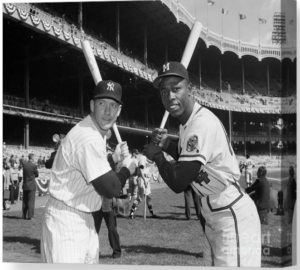
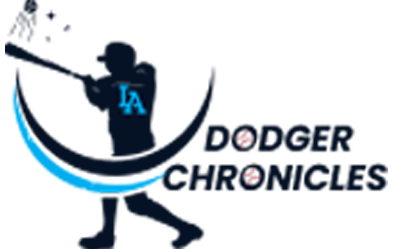
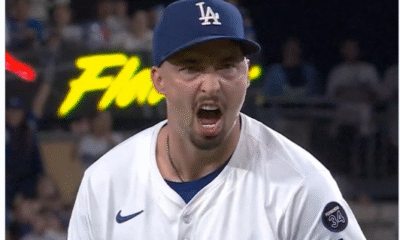

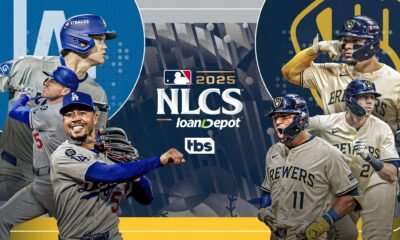

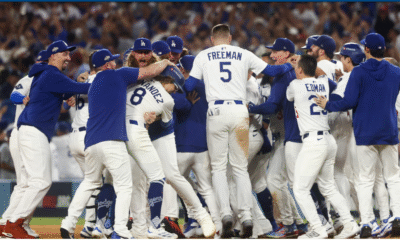

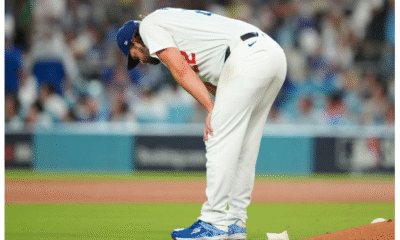





Thanks for the memories Rob.
Cerritos huh? As I recall that was a farm community. What high school did you go to?
I didn’t miss those shows back then. I don’t watch the home run derby’s of today. I did for a while, as I did with the slam dunk contest. Honestly I could do without the All Star game as well. Come to think of it, I don’t watch any of them anymore, though I’ll probably tune in this year.
Cerritos was known as Dairy Valley until the late 60s. It, for a period of time, produced the most milk of any city in the USA. The smell of cow manure was always in the air. Despite that, it was a great place to grow up. Plus, it was surrounded by the “larger “ communities of Bellflower, Artesia, Norwalk, Lakewood, and Cypress which gave us access to the city life.
i attended Richard Gahr High School. My freshman year, 1965, was the year it opened.
As I recall, you grew up not to far from there. Where did you live and go to high school?
Like you, I don’t watch the All-star game anymore. I confess to watching the home run derby when Joc Pederson and Vlad Guerrero went toe to toe, but that was it. I gave up watching pro basketball many years ago. I also stopped watching pro football.
I moved from Canoga Park to Los Alamitos in ‘62. 9th grade at Oak Junior High. Los Al High wasn’t built yet so we drove 7 miles to Western. Marina was about the same distance and most of us preferred going there. At the time we thought Huntington Beach was much cooler than Anaheim. Both schools were in the Sunset League, which was back then a powerhouse. I remember the name Gahr but don’t recall playing them in sports.
Loved watching Home Run Derby. Thanks for the memories, Rob.
I watched it a few times, but Saturday was my day to do chores, so I missed a bunch of them.
Great article, Rob. I loved HR Derby and can’t believe it was only around for the one season.
I grew up in Hollywood (Hollywood High) and luckily didn’t have any farm chores to keep me away from the TV when the Derby was on. I was a Hollywood Stars fan so was very familiar with Mark Scott. Didn’t realize he was so young when he passed away.
I must take you to task, however, for incomplete information in your article. Any decent researcher would have given me the names of the outfielders and John Van Ornum’s minor league stats. I’m not sure you should be allowed to post any articles here in the future.
Do you happen to remember if there was a version of HR Derby that Steve Bilko participated in? I seem to remember something and, of course, I hated Bilko, being a Stars fan.
I take full responsibility on this one. When rob or Harold send me their posts, and my sole responsibility is to tag each name and link it to their Baseball-Reference stats, MiLB Stats, or wiki page (if no baseball stats). I found that I did not tag John Van Ornum or Art Passarella. That has now been remedied.
I need a good editor. 😁😁
John Van Orwho? Never heard of him Figures it would be a Hollywood High kid who makes obscure requests like that one. Those Hollywood kids. Something in the water up there.
You insult me, sir!
Although now that I think of it the water in the water fountains did taste a bit strange.
Old pipes. Probably lead. Hollywood High also was an old Masonic Temple. Some weird karmic ju-ju connected to that too. Face it Jefe, you could use some intense therapy. Save me a seat.
Haha. Just what you signed up for Jeff. Some clown (me) forcing you to put even more work into your blog.
And thanks, Rob, for the extra work to follow up on my demands. I wonder when Mr. Van Ornum was last mentioned on the internet. His relatives wil be pleased.
STB – I’m sitting here hanging my head in shame. I did look for the names of the outfielders, but couldn’t find them. I did not, however, look up Van Ornum’s minor league stats. However, I have now repented from the error of my ways: Van Ornum played 5 years of minor league ball, never rising above Single A. He also played 95 games in the Mexican League. He finished his64, with a .264 BA, 36 homeruns, 237 RBI and a .783 OPS. I found this little bio on him:
“John Van Ornum done it all in the game of baseball as he was a professional baseball player, manager, coach and scout. From 1980 through 1984, He served as the bullpen coach of the San Francisco Giants of Major League Baseball.Primarily a catcher during his six-year minor league playing career (1959–64), he was a member of the Los Angeles Dodgers and Los Angeles Angels organizations, he then managed in the Giants’ farm system from 1973–78. After Coaching undr Dave Bristol, Frank Robinson and Danny Ozark, He then worked as a Major League and advance scout for the Giants, Dodgers, Angels and Atlanta Braves through 2004.As a 20 year old minor leaguer he served as the catcher on the 1959–60 television series Home Run Derby.”
I’ll strive to do better in the future. 🙂 🙂